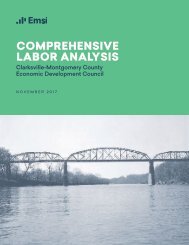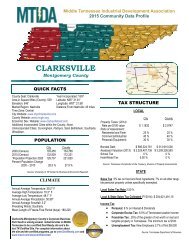vital_signs_2015_web
Create successful ePaper yourself
Turn your PDF publications into a flip-book with our unique Google optimized e-Paper software.
Takeaways For Improving Health Outcomes in Middle Tennessee<br />
It is clear that much work remains to improve the health and well-being of Middle Tennessee residents. While the region’s residents experience low levels of<br />
asthma, other areas, such as heart attack, physical activity, smoking, COPD, obesity and high stress, demand attention and action. To guide action, Middle<br />
Tennesseans should:<br />
• Take advantage of our health care system to positively influence health outcomes in Middle Tennessee. Compared to peer regions,<br />
our residents are more likely to be insured and more likely to take advantage of health care services. With our residents now accessing services for<br />
chronic diseases, there are opportunities to engage with individuals around a broader continuum of health and well-being that ultimately can mean<br />
cost savings, improved health and productivity.<br />
• Expand health insurance coverage to Middle Tennesseans without coverage. There are 269,750 Middle Tennesseans without health care<br />
coverage, making it more difficult for them to access the quality care that exists in our region. It is imperative that the state and region work to<br />
expand insurance coverage to ensure that more of our residents can access preventive care and treat chronic health conditions.<br />
• Strengthen partnerships between health departments and community organizations to better serve low-income Middle<br />
Tennesseans. Data suggest that poor health outcomes do not impact all Middle Tennesseans equally. Low-income individuals are twice as likely<br />
to report being in poor or fair health. Public health departments can play a crucial role in strengthening partnerships, through shared data and<br />
coordinated strategies, with community organizations that support populations that are disproportionately impacted by poor health.<br />
• Enhance the public infrastructure to promote healthy living. Neighborhoods are often separated along socioeconomic lines, with varying<br />
access to factors that promote or, if missing, deter healthy living. As the region works to develop and redevelop neighborhoods, opportunities for<br />
increased access to bicycle and pedestrian pathways, transit, healthy foods and services, and open space should take priority.












